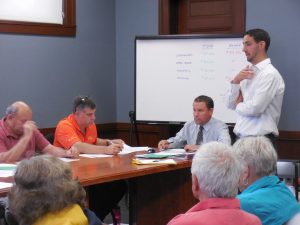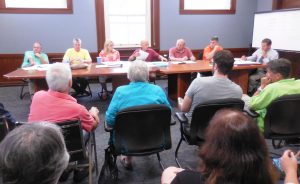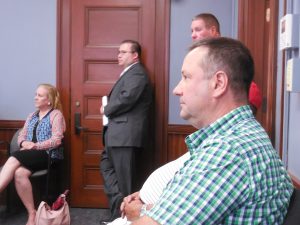
The Community Preservation Committee considered the request for CPA funds for the Rail Trail on Thursday. (Photo by Amy Porter)
WESTFIELD – The Community Preservation Committee considered the City of Westfield’s request for $250,000 for design work on the Columbia Greenway Rail Trail in front of a room full of city councilors and Rail Trail supporters on Thursday. While the discussion was mostly supportive and ultimately victorious, concerns were raised about the legality of using CPA funds for the work.
CPC Chair Joe Muto opened the meeting asking if anyone wanted to speak on items other than those on the agenda. Ward 4 Councilor Mary O’Connell, one of nine councilors attending the meeting, asked if people would be allowed to speak on agenda items as they came up, and Muto said they would.
City planner Jay Vinskey gave an update on available Community Preservation Act funds, which amounted to $315,000 in the undesignated category, and $50,000 each in Open Space, Historic and Housing. CPC vice chair Thomas E. Sharp asked what percentage match for CPA funds was included in the Governor’s budget for the next fiscal year, to which Vinskey replied 15%. He said originally the state matched the CPA funds at 100%.
Sharp replied that there were significant requests in front of the committee that could spend all the remaining funds. He said he was concerned that the funds would not be replenished at a very great level.
“We always looked at the state match as gravy. There is enough to cover what’s before you right now,” Vinskey said.
Muto then opened the Rail Trail discussion, inviting Jeremy Cigal, assistant civil engineer to speak on behalf of city engineer Mark Cressotti, who was away. Cigal said there were five bridges in the Rail Trail, one on East Main Street, bridges crossing side streets and a historic bridge over Elm Street with 20 feet in width. He said work began this week on the railroad bridge over the Westfield River.
“We’re right up against a timeline. If we don’t get the design done, we’ll be bumped,” Cigal said, referring to the $6.25 million state and federal match for the central portion of the trail, currently slated for 2019.

Assistant Civil Engineer Jeremy Cigal addressed the CPC Committee on behalf of the Engineering Department. (Photo by Amy Porter)
Cigal went on to say the $250,000 before the committee was for this year to keep them moving. He said the design work included a list of things the state won’t pay for, including lighting, amenities and right of way easements. He also said there would be additional work at a similar cost to the city for the next two years. He said the first year of funding would be dedicated to design work, the second year to design and right of way, and the third year to construction. Cigal referred to a letter sent to the committee by the city, which asserted that the Rail Trail fit well with the goals of the CPA.
“Would you expect to come back here for three consecutive years for the funds,” asked Vincent Olinski, the Parks and Recreation Commission member on the committee, to which Cigal replied they would.
“I feel the return on the investment is significant funding coming back, something we always pursue,” Muto said. He also said he would like to see signage on the trail that CPC funds were used.
A discussion followed concerning the appropriateness of using CPA funds for the design work on the trail. Vinskey said several communities have used CPA funds in the same way. Cigal said the city’s Law Department had been consulted, and concurred. Vinskey also said that prior to 2012, CPA funds would not have been allowed for use on parks not purchased with CPA funds, but the laws had changed.
“This is certainly a project everyone is in favor of, I just want to make sure nobody comes back at us,” said Historical Commission representative Cynthia P. Gaylord.
Sharp asked how the rest of the trail was funded, as this was the first time the city had come before the CPC. Community Development director Peter J. Miller said construction of the Rail Trail was initially funded by a Gateway Cities Environmental Affairs grant. He said the central and northern portions are being funded by MassDOT through federal money administered by the Pioneer Valley Planning Commission. Miller added that the design work had always been funded through the city’s general budget, and starting in 2010, the City Council passed a five-year bond to pay for design. He said the bond had expired, and more funding was needed.
Vinskey added that funds for recreation had to come out of the undesignated CPA funds.

The Communiity Preservation Committee discussion of the Rail Trail on Thursday. (Photo by Amy Porter)
Muto then opened the meeting to comments from the floor, recognizing Ward 6 Councilor William Onyski. Onyski said that during the budget meetings the councilors did their best to make cuts. They cut $250,000 from engineering, knowing there was a different avenue. “This seemed to fit the bill perfectly,” Onyski said. He reminded the committee that the city would be getting $6.25 million after investing $250,000, for three years. “There are a lot more people on the trail than go through City Hall,” Onyski said.
“I appreciate your blunt honesty about the budget, transferring it from your backs onto ours,” Sharp responded. He added that what they were really asking them was to commit half of their budget “which really ties our hands.”
“We are not committing to three years at this point,” said Muto.
Ward 3 Councilor Andrew K. Surprise said that he did support the Columbia Greenway, but “as many as you are here tonight, there were three times as many that came to our budget hearing.” He added that he appreciated the passion of the Friends of the Columbia Greenway Rail Trail (FOCGRT). “The way I look at it is, this is a component of the revitalization of our downtown that meets three criteria, recreation, historic and open space. We just don’t have it in our budget. We cut $400,000, but couldn’t agree on anything else without cutting services,” Surprise said.
At-large Councilor Cindy C. Harris noted that she had not voted to cut the funding from the budget, but was there to support the CPC funding. “It’s unfortunate, but I appreciate how hard it is for all of you,” she said.
Dan Call, a member of the FOCGRT handed out a packet of information to the committee. He said the $6.25 million grant from the Mass DOT is currently in play for 2019. He also said the grant could be delayed or given to other communities if the funding is not secured. He later added that the key to getting the money would be to complete the design for the central phase, which would complete the design for the entire 3.2 miles, but time was critical. “There are 27 towns that come under the PVPC jurisdiction. Somebody else could come along and say we are ready,” Call said.
Thomas Smith of Holyoke said that he came to the meeting to share his experiences over the last six years with legal issues with the City of Westfield, referring to his role as plaintiff in the Ashley Street School project. He said CPA funds were not used to acquire the trail, which may eliminate some avenues for the funds. He also said design work is not preservation, and urged the committee to be cautious.
“I would get an opinion from the state CPA – not just the city solicitor. I would look for the best legal opinion you could get. You can’t go by what other towns did,” Smith said, adding that each project is considered individually.

In all nine councilors attended the CPC discussion. Pictures are Councilors Cindy C. Harris, Andrew K. Surprise and WIlliam Onyski, and DPW Director David Billips. (Photo by Amy Porter)
Ward 2 Councilor Ralph J. Figy said that most of the Rail Trail goes through his ward. He said the central phase will be more than recreation, because it will elevate the Thomas Street Bridge and preserve the Elm Street Bridge. He said since the start of the Rail Trail project it has gone from not being seen as a positive, to being a positive for the city. “Today, I had two businesses put out a bike rack. It is having an impact,” Figy said. He added that he was willing to put his name on the line as a city councilor.
Ward 1 Councilor Mary Ann Babinski said that she hoped they could get answers to some of the questions regarding the appropriateness of the funding. She also talked about the “Bridge to Somewhere,” (referring to the railroad bridge), saying that people on the north side need to feel connected to the rest of the city. “They call me and send me emails about how great it will be for them to be a part of this project. This is what they want. Some of these issues, I hope we can resolve,” Babinski said.
“All of us certainly agree with you. I think we need some answers,” Gaylord said.
Miller said there were still five or six weeks until it would go before the City Council on August 24 “to make sure that this is buttoned the right way.”
“My question is, do you have before you the Law Department’s opinion,” O’Connell said. Muto said no letter was included in the application. “A mistake is costly. To me, it would be wise to get all of the questions answered,” O’Connell added.
“I of course am in support of funding this project,” said At-large Councilor Stephen Dondley, who also said he did not vote for the budget cut. “I’m specifically concerned about the timeline of this. Mark Cressotti said he needs this money as quickly as possible,” he added.
FOCGRT member Don Podolski said that approval of the funding would lead to the culmination of years of work on the Rail Trail and the completion of its design. He called the Rail Trail a “historical educational corridor” for the city.
Public Works director David Billips said that along with the Engineering Department, he was responsible for fixing the roads in the city. He said he watched the City Council debate on the “Bridge to Somewhere” because of the prior $3 million grant that they wanted to spend on the roads. “You can’t spend it on the roads,” Billips said. He added that in the past the city has lost funding because they haven’t been ready when it became available.
Billips also said that the city has an excellent city planner, Community Development, Law and Engineering departments, and if they said the funds can be used, then they can. “The DPW supports this completely,” Billips said.
Miller meanwhile had retrieved the letter from the Law Department and read it to the committee. The letter noted that in 2012 the law had been broadened to allow for CPA funding of improvements of recreational facilities. It also noted that the land is currently not dedicated for recreation space, and the CPC request should include preservation. “It’s unquestionably eligible,” Miller said. He also said that by funding this, the CPA’s job would be to put a restriction on it.
At-large Councilor John J. Beltrandi, III said that as a City Councilor he had never received more input as he had on the Rail Trail. When asked by Muto if any of the comments had been negative, Beltrandi said he did have a couple of people say the money should be used for the roads, but he told them it was earmarked for this purpose. “This horse is out of the barn. We can’t stop now, we have to finish the project,” Beltrandi said.
At-large Councilor Matthew T. VanHeynigen said he was a former Planning Board member before joining the City Council. He noted the strong public benefit of the project, and the sheer numbers of supporters throughout the city.
Onyski also referred to his thirteen years on the Planning Board. “We value the opinion of the Law Department. They would be the ones to go to Boston. We don’t second guess the Police Department. I don’t think planting seeds of doubt is appropriate. We need to trust our Law Department,” Onyski said.
CPC member William Carellas, representing the Planning Board, said he is on the Rail Trail three times a week himself, and is in favor of the funding. He also said the Rail Trail probably saved his life from getting killed riding on Shaker Road. “I think the Committee would be remiss if they didn’t listen to Mr. Smith and do our due diligence,” he said. He also questioned whether they were tying their hands for the future. “It’s $250,000 this year, but in reality for three years,” he said and asked the councilors for their help in the funding.
Surprise said it would depend on revenue, and that the state will be having big revenue shortfalls for the next three years.
CPC member Daniel Kelly of the Housing Authority said it was very important that the CPC approve the $250,000 this year, and moved the question.
Vinskey repeated that the qualifying category for the grant would be under recreational preservation. A roll call vote was taken to unanimous support of the grant of $250,000 for the Rail Trail, which was followed by applause from those present at the meeting.

